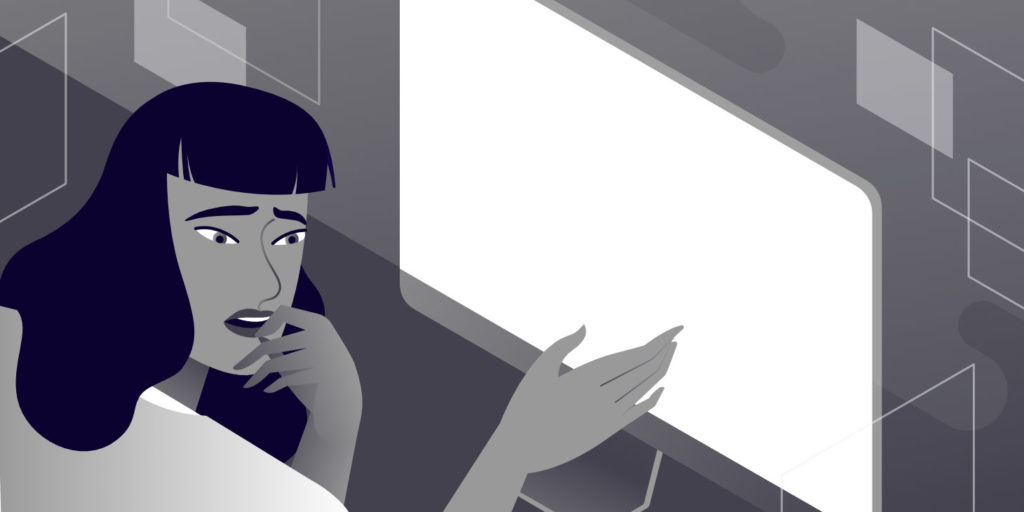Nothing is worse than browsing to your WordPress site and suddenly being met with the White Screen of Death (WSoD). This error makes your website inaccessible to both administrators and visitors.
The WSoD can also be incredibly frustrating, due to the lack of information pointing to a possible cause or solution. However, it is also one of the most common WordPress errors. So while concerning, in most cases it’s resolvable.
In this post, we’ll explain what the WordPress WSoD is and what its common causes are. Most importantly, we’ll walk you through nine potential solutions for getting your site back up and running as fast as possible.
Let’s get started!
Check Out Our Video Guide to The White Screen of Death
What’s the WordPress White Screen of Death?
True to its name, the WordPress White Screen of Death (also known as “WSoD”) occurs when, instead of the web page you’re trying to access, you’re faced with a blank white screen in its place.
Depending on the browser you’re using, you could get different error messages. Below is an example in Google Chrome, which includes an HTTP 500 error warning “This page isn’t working and is unable to handle the request”:
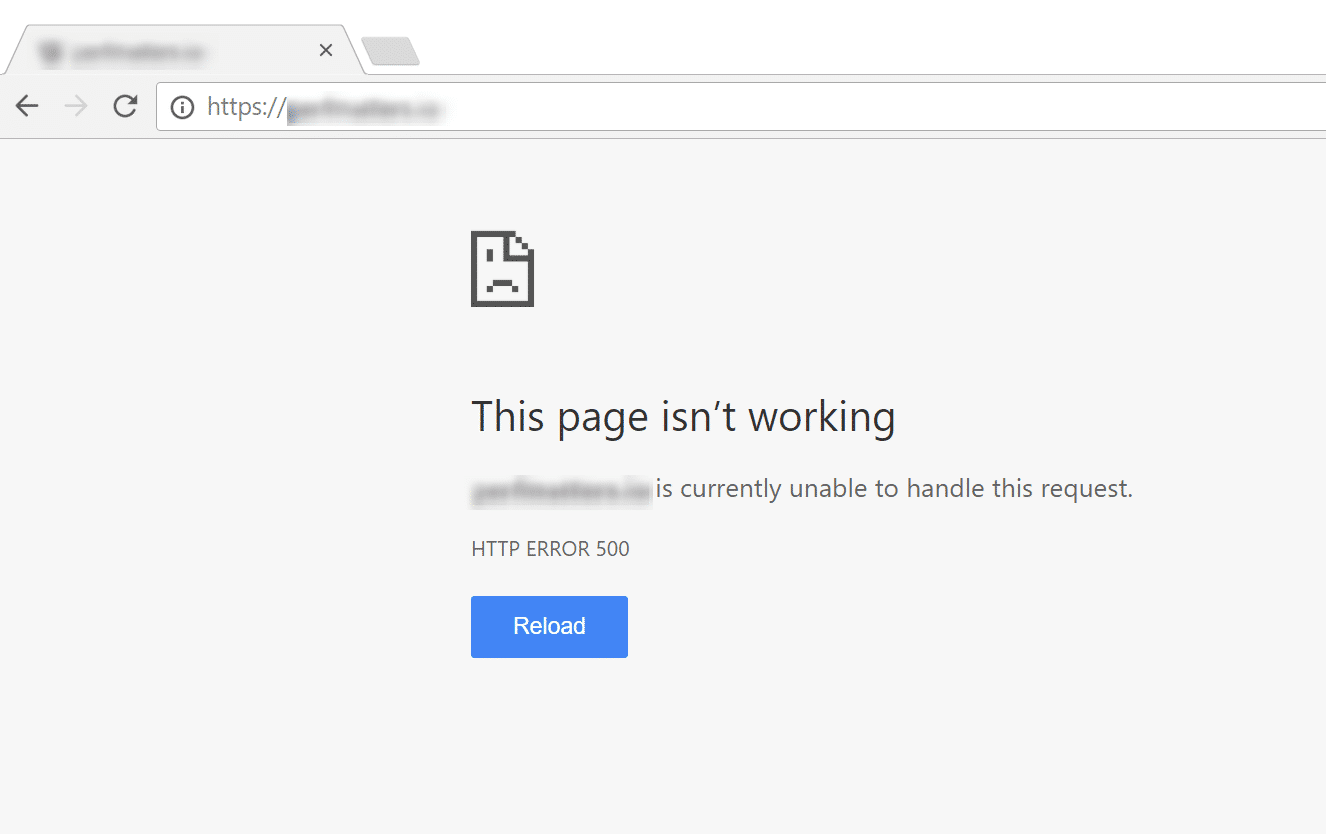
Now let’s take a look at the White Screen of Death in Mozilla Firefox:
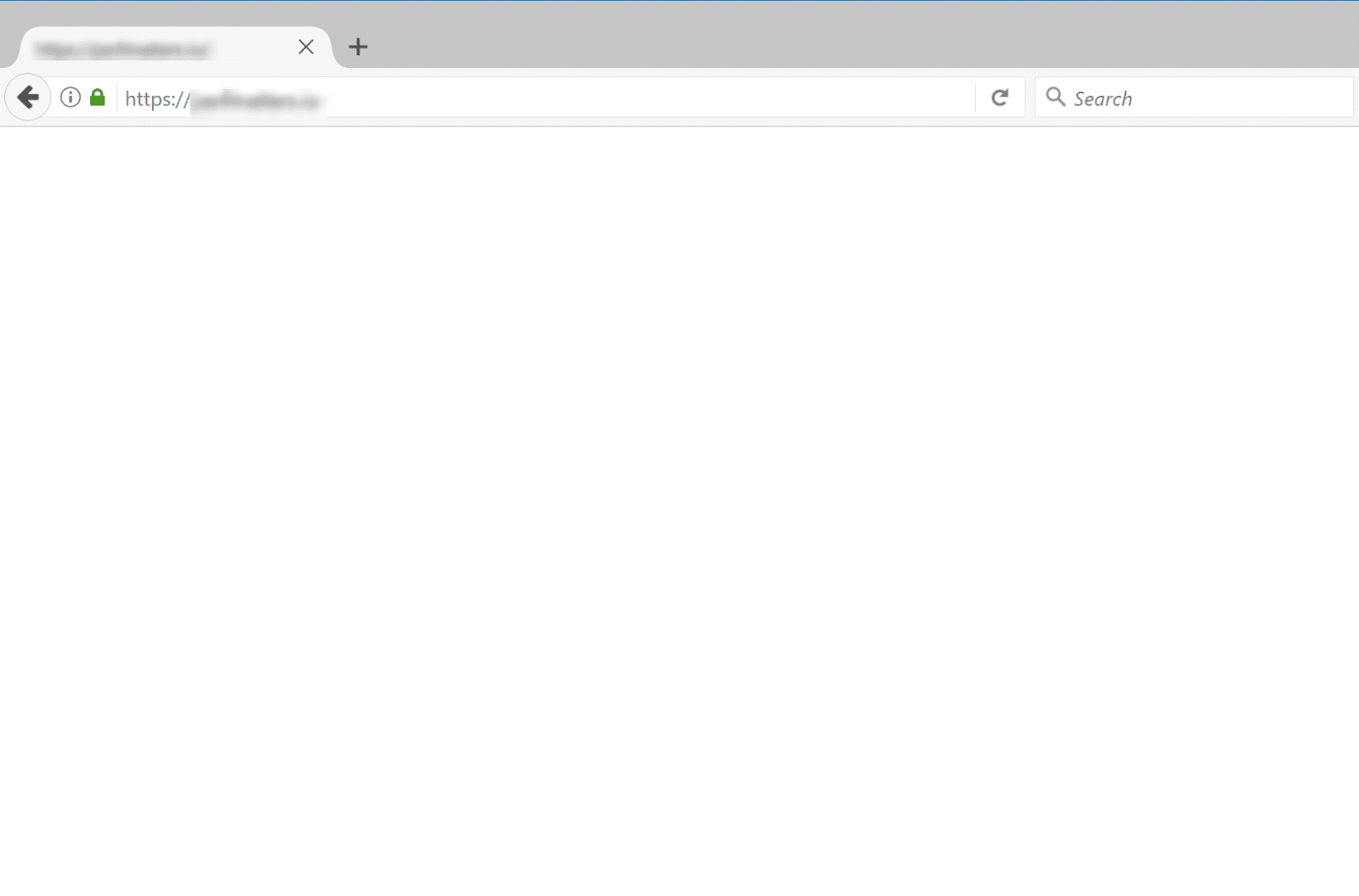
As you can see, it’s just a plain white screen. It doesn’t contain any useful errors or warning messages.
The WordPress White Screen of Death is almost always caused by PHP code errors or memory limit exhaustion.
Another possible cause is a faulty theme or plugin. The latter is likely the issue if the frontend of the website is down, but your WordPress admin area is up. To quickly check whether the dashboard on your site is working, simply navigate to yourdomain.com/wp-admin.
So, how do you fix WSoD? Glad you asked!
How to Fix WordPress White Screen of Death (9 Methods)
When you experience the WordPress White Screen of Death, your priority will be to fix it as quickly as possible. With that in mind, let’s take a look at nine possible solutions you can use to resolve it.
1. Disable Your WordPress Plugins
One of the easiest and most common ways to fix the WordPress WSoD is to simply disable all of your plugins. Often, a site goes down due to a bad plugin update.
If you can still access your admin area, a quick way to do this is to navigate to Plugins from the dashboard, select all plugins, and then click on Deactivate from the Bulk Actions dropdown menu:

This will disable all of your plugins.
If that fixes the issue, you’ll need to find the culprit. To do this, you can start activating the plugins one by one, reloading the site after each activation. When your frontend goes down, you’ve found the misbehaving plugin.
You can then reach out to the plugin’s developer for help or post a support ticket in the WordPress Plugin Directory.
If you can’t login to WordPress admin, you can use a File Transfer Protocol (FTP) client to access your site’s files directory.
Under the wp-content folder of your root directory, locate the plugins folder. Rename it to something along the lines of “plugins_old”:
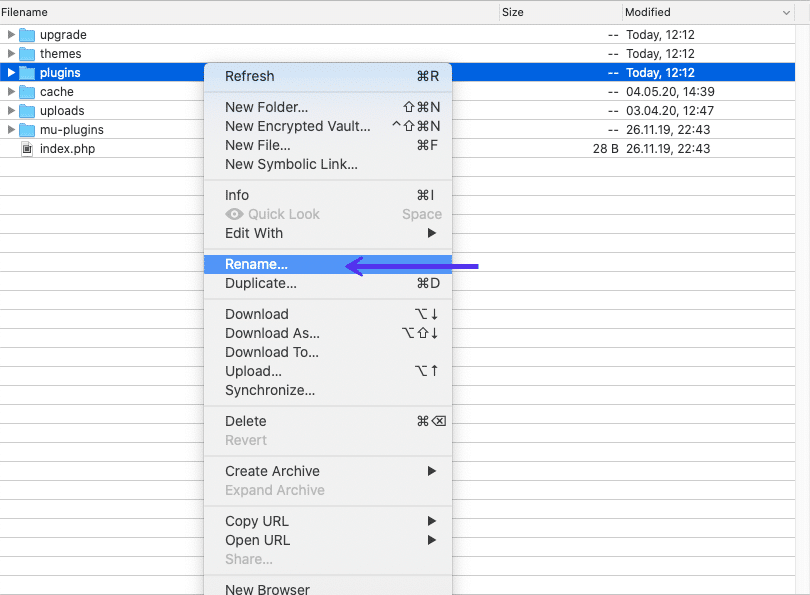
Then, check your site again on the frontend. If this works, you will need to test each plugin one by one. Rename your plugin folder back to “plugins”, and then individually rename each plugin folder inside of it until you locate the faulty one.
2. Switch to a Default WordPress Theme
If the problem isn’t a plugin, your WordPress theme may be the cause of the White Screen of Death. To see if this is the issue, you can replace your theme by switching to a default one.
If you can access your admin area, go to Appearance > Themes in your dashboard. Locate and activate a default WordPress theme such as Twenty Twenty:

Then, test your site again. If it works, you’ll know the problem lies with your theme.
If you can’t access your dashboard, the process is the same as it is with plugins.
Use FTP to access your site’s files, and rename your wp-content/themes folder to something else:
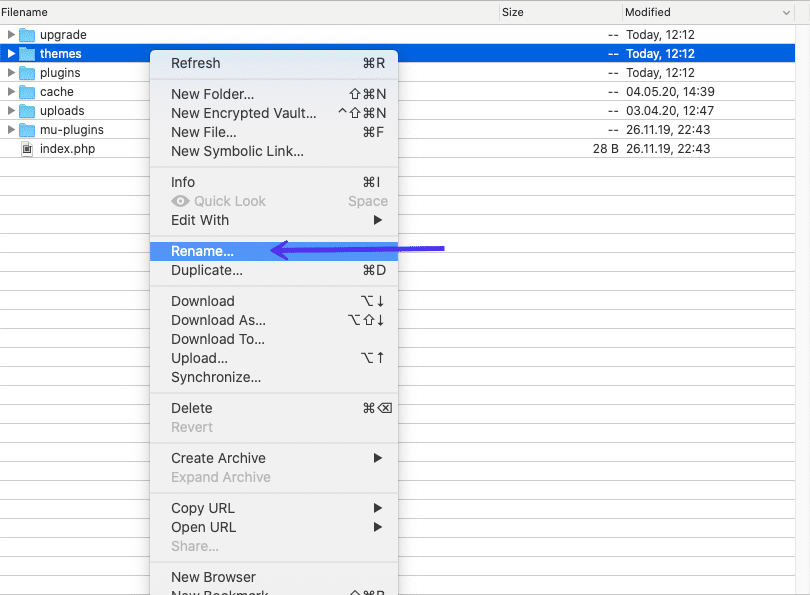
WordPress will then revert to the latest default theme, which is most likely Twenty Twenty. If you don’t have any other themes, you can download one from the WordPress Theme Directory and then upload it to your themes folder.
After that, go ahead and check your site again. If it works, perhaps your theme has had a conflict or a bad update. If this is the case, you might need to reach out to the developer for help or consider switching themes.
Plugin and theme updates can be handled quickly and easily using the Kinsta Automatic Updates add-on in the MyKinsta dashboard.
3. Clear Browser and WordPress Plugin Cache
If you have access to the backend of your WordPress site but are still seeing the WSoD on the frontend, it might be due to an issue with your cache.
To fix it, try clearing your web browser’s cache and your WordPress caching plugin (assuming you have one installed).
If you have a caching plugin installed on your WordPress site, such as WP Rocket or WP Super Cache, most offer a quick way to clear the cache via the plugin’s settings page.
Using WP Super Cache as an example, in your WordPress dashboard you would navigate to Settings > WP Super Cache > Delete Cache:
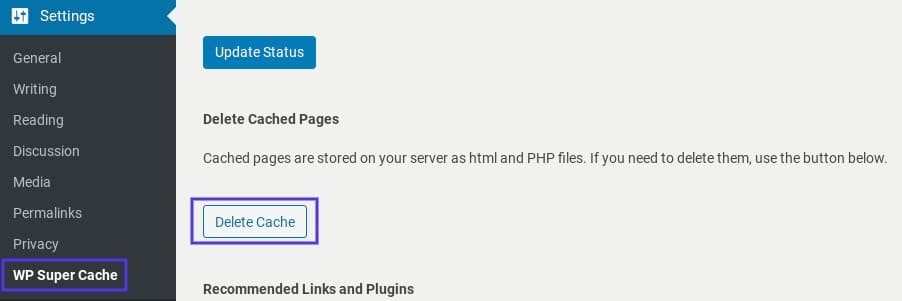
How to Clear Your Cache from MyKinsta
If you’re a Kinsta user, there’s also an easy way for you to clear your cache using MyKinsta. To do this, log in to your account. Click on Tools, followed by Clear cache under the Site Cache section:

Once you empty the cache, save your changes. Then revisit your site to see whether that corrected the issue. If not, it’s time to move on to another solution.
4. Switch on Debugging Mode
If you are still seeing the WordPress White Screen of Death, the admin area isn’t working, or you think you’ve found the problem but want to dig deeper, you can enable debugging mode. This will show any errors that are occurring on your website.
To enable debugging, you’ll need to open the wp-config.php file of your WordPress install. Within it you should find the following line:
define( 'WP_DEBUG', false );Change “false” to “true”, and then reload your site. If this line doesn’t exist, you can add it to the top of the file.
Instead of the white screen, you’ll get a white screen and some error messages. This isn’t a huge improvement, but it’s only a start. The WSoD error message should state which file the problem originated in, like this:
Cannot redeclare get_posts() (previously declared in
/var/www/html/wordpress/wp-includes/post.php:1874) in
/var/www/html/wordpress/wp-content/plugins/my-test-plugin/my-test-plugin.php on line 38You can see at the end of this example message that the problem is in line 38 of a plugin called my-test-plugin. Therefore, disabling that plugin should resolve the issue.
If you don’t see any errors at all after enabling debug mode, you might need to reach out to your web host. It’s possible debugging isn’t correctly configured on your server.
Kinsta customers have the option to use a built-in debugging tool. From the MyKinsta dashboard, click on your website’s name followed by Tools. Under WordPress debugging, select Enable:

You can then access your error log under the Logs section of your MyKinsta dashboard, and explore them to learn more about the problem.
Keep in mind that having the debugging mode turned on can expose some of your website’s information to unapproved users. Therefore, make sure to always turn the mode off when you’re done using it.
5. Increase Your Memory Limit
If you still see the dreaded WSoD empty page after trying some of the above solutions, or you get an error complaining about memory limits or exhausted memory, you’ll need to assign more memory to the application.
This can be done through the wp-config.php file on many WordPress installs. Open the file and add the following code:
define('WP_MEMORY_LIMIT', '64M');If this doesn’t seem to work, you have a few options. In a regular environment, you can use your .htaccess file to increase the memory limit. Simply add the following line:
php_value memory_limit 64MIf you can’t access your .htaccess file, you can use your php.ini file to increase the memory limit instead.
To do that, connect to your server via FTP. In the root directory of your site, look for the php.ini file. Once you locate it, add the following line anywhere inside the file:
memory_limit = 64MIf you’re still out of memory and need to assign more, there may be an issue within your application. Perhaps your theme or one of your plugins is using an inordinate amount of resources.
At this point, you may want to hire a developer to take a look. Even your host may be able to help, by showing you the SQL logs and other resource stats for your site.
6. Check File Permission Issues
Another potential cause of the WSoD is permission and ownership issues. It is possible to fix this problem yourself. However, unless you really know what you’re doing, we would advise against it as you can inadvertently create vulnerabilities that attackers can exploit.
When it comes to WordPress permissions, there are three simple rules to follow:
- Files should be set to 664 or 644.
- Folders should be set to 775 or 755.
- The wp-config.php file should be set to 660, 600, or 644.
If you have SSH access to your server, you can apply the appropriate rules with the following command, running it from the root WordPress directory:
sudo find . -type f -exec chmod 664 {} +
sudo find . -type d -exec chmod 775 {} +
sudo chmod 660 wp-config.phpIf you are unsure how to do this or are a bit intimidated, go ahead and ask your web host for help.
7. Check for Failed Auto-Update Issues
Sometimes WordPress runs into an issue with updates, such as when the server times out. More often than not, this problem resolves itself automatically. However, in some rare cases, it may lead to the WordPress White Screen of Death.
The first thing you should do is go into your WordPress root directory and see if there’s a .maintenance file there (the file’s name may be abbreviated as well).
What you’d want to do is try deleting that file and loading up your site again.
If the update was successful, but WordPress failed to remove this file automatically, everything should go back to normal.
If the update was not completed, it may be restarted automatically, in which case things should go back to normal just the same.
If all else fails, follow the recommended manual update procedure for WordPress, which should resolve the issue once and for all.
8. Resolve Syntax Errors or Restore a Backup
Another common cause for the WordPress WSoD is when you’re editing the code on your WordPress site and accidentally mistype something or use the wrong syntax.
One character in the wrong place could take down your entire site, which is why you should never edit code on your live production site.
Not to worry, though. You can always connect to your site via FTP and revert the change you made manually. If you don’t know what change caused the problem, this is where having WordPress backups in place comes in handy.
Here at Kinsta, you can restore your site to an earlier point in time with a single click. To do this, log in to your MyKinsta dashboard and navigate to Backups:

Keep in mind that if you enabled debug mode in WordPress earlier, there might also be an error message indicating a parse syntax error. If this is the case, it should tell you exactly where to find the problem code.
9. Increase the PHP Text Processing Capability
At this point, if the WSoD has not yet been resolved, there’s one additional trick you can try. On rare occasions, this problem might occur because of a page or post is particularly long.
If this is the case, you can try adjusting the PHP text processing capability on your site, by increasing the backtrack and recursion limits. To do so, paste the following code within your wp-config.php file:
/* Trick for long posts /
ini_set('pcre.recursion_limit',20000000);
ini_set('pcre.backtrack_limit',10000000);Once you add this code, save your changes. Then refresh your site to see if it’s now working.
Summary
The WordPress White Screen of Death can be incredibly frustrating, even frightening. There are a number of things that can go wrong, but thankfully the situation is usually not as bad as it seems.
A simple plugin and/or theme check should fix the WSoD issue in most cases. Getting more familiar with WordPress debug mode will definitely shed more light on the problem and guide you.
If you’ve encountered any other WordPress White Screen of Death situations, let us know so we can learn from it and share the experience!
